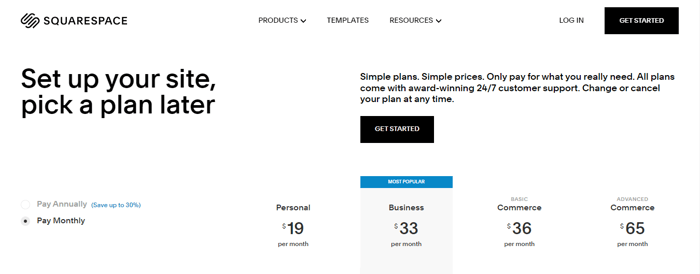Square and Squarespace share a similar name, so people often think that they’re either the same company or somehow related, but this is not true. They’re two different companies with very different origins, but they both offer website builders with e-commerce features, so comparing Square vs. Squarespace makes sense.
Square Online, in particular, is what we’ll compare to Squarespace today. It is a product of Square, the POS payment gateway giant. Square’s POS is used by thousands of companies for accepting credit and debit cards, cash, checks, and other forms of payment since 2009, and this was their main product for years. However, when Square acquired Weebly in 2018, they built Square Online on Weebly’s servers and launched their new product.
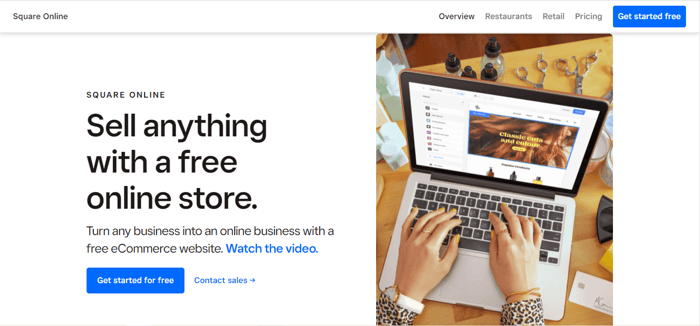
Square Online is perfect for new or small e-commerce businesses as well as for companies that already have a brick-and-mortar store and are looking to take their business online. It’s not ideally suited for large companies that have to juggle many things at once or for brands that like to stand out. Still, Square Online has a large body of happy clientele who like Square’s services in the website-building domain.
On the other hand, Squarespace is one of the most popular e-commerce platforms. In fact, 2022 usage statistics on W3Techs show that Squarespace is used by 2% of the top 10 million websites, putting it right behind Wix, Shopify, and WordPress, respectively. While 2% doesn’t sound like much, it’s not a small feat to be among the best given the competition.

Squarespace was launched in 2004, nearly two decades ago, and during that time, it quickly grew, eventually cementing its place among the most-used business software solutions. Squarespace is known for its visually-appealing templates, and it functioned for a long time solely as a website builder. In 2013, they added e-commerce functionalities by integrating with Stripe.
After being optimized as an e-commerce platform, Squarespace continued evolving and has turned into a very functional business software solution that’s perfect for both smaller and medium-sized businesses, especially those that want to stand out as a brand.
So, how do these two e-commerce platforms compare to one another? Let’s find out!
Table of Contents
Pricing Plans and Features
Generally, Square Online is more affordable than Squarespace and offers more features in its cheapest plan. But does that make it better? Not necessarily, as this is just a fraction of what you should consider when comparing these two platforms. Let’s review what they both offer.
Square Online
What sets Square Online apart from many other e-commerce platforms is that it offers a fully functional free plan, meaning that while it allows you to build and design a website, you can also make sales. Not too shabby, right? With no monthly payment and 2.9% + $0.30 per transaction, we have to admit that the Free plan is pretty impressive for a free plan. It’s basically a good way to get your e-commerce business started before you need to upgrade.
The Free plan includes some of the following features:
Unlimited bandwidth and 500 MB storage
SSL security certificate
Mobile-friendly site
Selling unlimited items
Selling on social media (Instagram, Facebook, and Pinterest)
Different shipping and delivery options (in-house, in-store and curbside pickup, and on-demand delivery)
Order status texts
Different payment options (Apple Pay and Google Pay, Afterpay, and Square Pay)
SEO tools (add SEO page titles, meta descriptions, and permalinks)
Marketing tools (manage Facebook and Google ads)
All of these features are great and useful, no doubt, but since this is a free plan, there’s always a “but.” In this case, the Free plan doesn’t support adding a custom domain name – instead, your website will reside on Square’s subdomain and end in “.square.site.” Moreover, Square’s branding will always be shown on your website. And lastly, Square’s native payment gateway is the only one that’s supported (meaning no PayPal and the like).
The Free plan can be a good starting point if your budget is tight, but you still want the basic e-commerce functionalities.
If you want more features, you’ll need to upgrade to one of the paid plans billed annually. All paid plans support adding a custom domain name that you already own or registering one through Square. The domain name is free in the first year if you register it or transfer it from a third-party service to Square. After that, you’ll have to pay for it additionally, starting at $12.
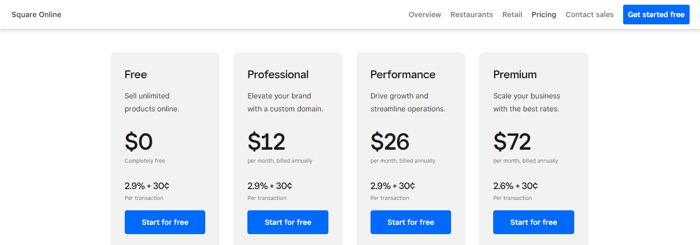
Professional
The Professional plan costs $12 per month and, as expected, it offers more features. Apart from being able to use a custom domain name, you can also:
Remove the Square ads from your site.
Get access to unlimited storage.
Upload and use custom fonts.
Password protect pages in the editor.
Get access to detailed site statistics (number of visitors, most visited pages, etc.).
This plan is also pretty good if you’re on a tight budget but can afford to pay for the additional features that are not included in the free plan. It could work really well because, for one, having your own domain name as opposed to a subdomain will make your site look more professional, not to mention the absence of the Square ads. Plus, being able to get detailed site statistics will definitely help you gauge how your site is doing and help you improve your business.
Performance
At $26 per month, the Performance plan doesn’t look very different from the Professional plan, as most of the features are the same. The biggest difference is that this plan lets you accept PayPal payments, which is kind of important. Apart from that, the Performance plan takes it up a notch by including the following features:
Access advanced e-commerce statistics (sale trends and voucher usage, as well as how your products are performing).
Automatically request product reviews from your customers and post them under the product site.
Send abandoned cart recovery emails to encourage your customers to complete their purchases.
Add gifting options (having the product gift wrapped for a fee, adding a message, and including a gift receipt).
In our opinion, this plan may be your best option if you have the budget. Compared to other e-commerce services, the features included here offer a good value for the money because they can help your business grow and can generally make your job a little bit easier.
Premium
The Premium plan includes everything else from the previous plans with one big addition – real-time shipping rates based on destination, weight, and carrier. This is quite an important feature, but considering that this plan costs $72 per month, you should think about whether it’s worth it.
If your earnings can cover the annual costs of the Premium plan, then that’s great. It means you’re doing pretty well, and your business isn’t so small, after all. However, in that case, you might get better value for your money if you opt for a different e-commerce service that can accommodate your growing business even better, such as Shopify or WooCommerce, or even Squarespace.
Transaction Fees
Square Online charges 2.9% plus $0.30 per transaction for the Free, Professional, and Performance plans, while for the Premium plan, the transaction fees are lower – 2.6% plus $0.30 per transaction.
It should be noted that if you use Square’s own POS, you won’t have to pay any additional payment processing fees as you would if you were using a third-party payment processor like PayPal.
Squarespace
Squarespace offers four plans in total, starting at $19 per month. However, if you choose to pay annually, you get an up to 30% discount, which makes quite a significant difference in the prices.
While there’s no free plan, you can register for a free 14-day trial with most of the e-commerce features available, plus all of the custom code options (HTML, CSS, JavaScript). The trial doesn’t require leaving any credit card information, which is awesome. In addition, you can extend it by seven days if you need more time to explore.
Like Square Online, all of the plans include a mobile-friendly site, free SSL certificate, unlimited bandwidth, and photo storage, and you can connect or register a custom domain name for free in the first year, after which the price will renew at their standard rate, between $20 and $70. Finally, since Squarespace is a very visual platform, it also offers a 30-minute video limit on all plans, meaning that you can add visual interest to your site by uploading your own video of up to 30-minutes per page. You can find out more info about this feature here.
Personal
The Personal plan is Squarespace’s cheapest plan and the only one that doesn’t have e-commerce functionality. Basically, this plan enables you to build a good-looking and fully-functioning website, but that’s it. Here are the other features included in this plan:
SEO features to help you improve your site’s visibility
Collaboration between two contributors
Basic website metrics to track website traffic, popular content, and more
Ability to add third-party extensions supported by Squarespace to expand your site’s functionalities
Limited access to Squarespace Video Studio app
The Personal plan is a good starting point if you want to get your name out there and have no intention of starting a business just yet. For example, you can use this plan for portfolios or blogging, but in order to run an actual business, you’ll need to upgrade.
Business
The Business plan costs $33 per month and unlocks a lot more features and customization options that can help small and growing businesses run smoothly. Apart from the basic features, here’s what you get:
Unlimited number of products
Unlimited number of contributors for collaboration
Official Squarespace integrations to optimize your site and business even more
Customization with CSS and JavaScript (to revamp your chosen template by playing with code)
Advanced site analytics (apart from the basics, you also get detailed sales and conversion metrics)
Fully-equipped e-commerce functionalities including order, product, and inventory management, as well as payment, tax, and shipping tools
Ability to add pop-ups and banners to advertise promotions or make announcements
Ability to offer digital gift cards
Full access to Squarespace Video Studio app
Basic Commerce
At $36 per month, the Basic Commerce plan is where Squarespace starts to pull out the big guns. While the Business plan is pretty adequate for managing many aspects of your business, the Basic Commerce plan can help you to build a really solid base and establish your business by offering key e-commerce features in addition to the ones from the previous two plans. Check them out:
Use a POS system for in-person selling within the U.S. (Squarespace uses the Square POS for this; Square Online also allows you to sync your inventory and sales history on the spot and keep everything updated).
Enable your customers to sign up for an account (helps to build long-lasting relationships).
Apply powerful e-commerce analytics to get a detailed insight into best-selling products, sales trends, and visitor-to-purchase conversion.
Use handy merchandising tools (display related products, enable joining product waitlists, and do spreadsheet bulk editing to manage your inventory more effectively).
Sell your products on Instagram by creating shoppable posts on your Instagram feed to increase your reach.
Add availability labels on products so your customers know if a product is in low or limited stock to encourage interest and urgency.
Advanced Commerce
The Advanced Commerce plan costs $65 per month and is best suited for already established and thriving businesses whose needs cannot be covered by the other plans. This plan offers you:
Automated abandoned cart emails for customers who haven’t completed the checkout process.
Weekly and/or monthly paid subscriptions to products and services to increase engagement and revenue.
Real-time shipping rates for UPS, USPS, and FedEx.
Discounts that automatically apply when an order meets certain criteria or is limited to select products.
Squarespace commerce APIs (Inventory API, Orders API, Products API, Profiles API, Transactions API, and Webhook Transcriptions API). They allow you to build custom integrations with third-party servers to manage different aspects of your business.
Squarespace Enterprise
Squarespace changes its paid plans from time to time when they want to offer a new set of features or update old ones. In November 2021, they discontinued Squarespace Select and introduced Squarespace Enterprise, an e-commerce solution intended to help enterprise-level companies run their business as efficiently as possible. It offers a “customized plan and dedicated support,” as Squarespace puts it, and it comes with many useful features:
Integrated SSO (single sign-on authentication method).
Centralized dashboard for managing your account and ongoing projects.
Creating teams for collaborative work.
Security evaluation support.
SSL certificates.
Unlimited bandwidth and storage.
Dedicated account manager for your business (to help you with troubleshooting or anything else).
SEO support (in-house experts review if your site is optimized before being published).
Dedicated tech support for anything tech-related.
Design support (you can consult with UX and web design experts to help you achieve what you’ve envisioned for your brand).
White glove product training sessions for your team.

Squarespace Enterprise is a customized plan, which means the price will be tailored according to your needs and requirements. If you’re interested in using it for your business, you’ll need to contact the sales team directly and discuss your needs with them.
Transaction Fees
Squarespace charges a 3% transaction fee per sale only in the Business plan, which can add up if your pricing doesn’t cover it. Choosing the Basic or Advanced Commerce plans will relieve you from the transaction fees, but remember that you’ll still have to pay your chosen payment processor’s fees.
Squarespace allows you to accept payments through PayPal, Stripe, and Afterpay or Clearpay, and you can use Square’s POS for in-person purchases (currently only available on iOS devices).
Templates and Editor
The biggest difference between Square Online and Squarespace has to be in their website builder functionalities – there’s just an unmistakable difference, and not only because of the aesthetics. But what they do have in common, though, is that they’re both suitable for users who don’t have coding experience, making them relatively easy to use.
Square Online
Square Online has a pretty straightforward website builder that’s super easy to learn and navigate. Even people who have never used website builders of this kind can learn to use it. However, simple doesn’t mean not functional, as the Square Online website builder makes the most out of its simplicity, if that makes sense. Simply said, it was designed to be user-friendly and functional while still looking professional.

The design itself is pretty minimalistic, but it’s still very elegant. You only get one standard template by default, but Square Online also has a library of templates. However, you have to contact the sales team to use them.
The default template that you get doesn’t leave a lot of room for customization since it doesn’t have a code editor, but it still looks rather clean and nice. It’s organized into sections, so everything you need to customize your site is on the left, where you can add/remove new pages, sections, items, and categories. While you don’t have the freedom that comes with code-based builders, you can still edit all of the elements to an extent and create a nice-looking site.
Here’s what else you can do:
Change the font style or upload your own font (depending on which plan you use).
Upload your own logo.
Edit the header.
Add your own branding in the footer (only in the paid plans).
Change the layout of the elements.
Add your own background.
Change the colors.
Upload images to the image gallery.

So, as you can see, the Square Online editor was made to showcase your products in a simple yet effective way, making it perfect for brick-and-mortar stores that need an online shop. Small catering businesses would also find Square Online useful as well as DIY businesses, to name a couple.
Squarespace
The visual department is where Squarespace truly shines, as you may have already guessed. For a long time, Squarespace was primarily used by creatives to showcase their portfolios, but over time, it has broadened its range. Now, you can find a wider variety of businesses that use Squarespace.
What has remained, though, is that Squarespace is still a predominantly visual platform – it’s like their trademark. Therefore, making sure you upload high-resolution photos is a must. Squarespace’s templates were designed to be eye-catching no matter how minimalistic or intricate, and they were made to support your creativity no matter your tech knowledge.
Squarespace’s template library may not be as extensive as WordPress’s, but that doesn’t mean that you’ll have an easier time choosing one because all of them are 10/10.
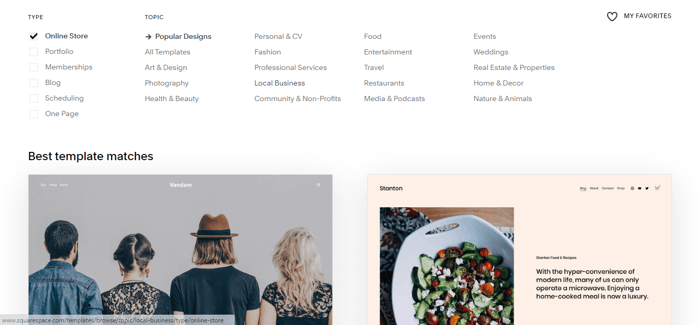
As you can see in the image above, they’re grouped into categories based on the type of business you run, and they’re optimized to fit the needs of your online store.
The templates themselves are quite structured, and in that sense, it can be said that they function similarly to the Square Online default template, but there’s a lot more freedom to customize them. The editor is pretty flexible, but unlike with the Square Online editor, you will need more than 10 minutes to really understand how it works. After that, it’s a breeze.
It’s also important to note that Squarespace’s editor is a drag-and-drop editor, but you can’t just drag and drop anything anywhere – there are limits. While this may be slightly frustrating if you have your own original vision, it can actually make editing your site less chaotic if you can’t decide whether a certain block of content looks better here or there.
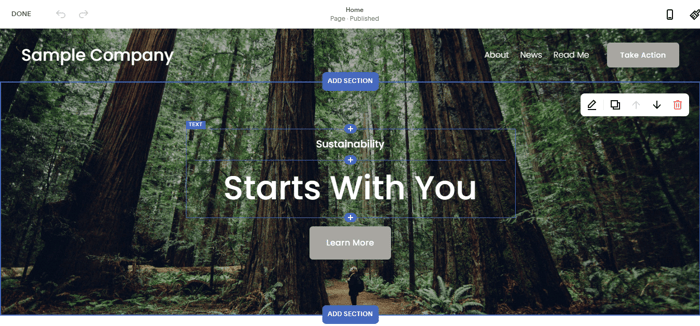
As you can see in the image above, everything is in sections that you can customize with one click – the fonts, colors, background, spacing, buttons, image blocks, and animation style of the elements. You can also use code to modify the fonts, colors, and backgrounds, but you can’t modify the layout itself.
One thing we weren’t crazy about is the absence of auto-save. You have to save your changes manually (and frequently) so you don’t lose it in the event that your browser crashes or the connection gets cut off, or you just accidentally close the tab while you’re editing. In some cases, it may be hard to recover lost changes. However, if you accidentally delete a page or a blog post, Squarespace lets you recover it if it’s been no more than 30 days. For more troubleshooting, check out their article.
Integrations
Square Online and Squarespace both have different approaches in the integrations department. While Square Online has a dedicated app marketplace where it offers integrations with over a hundred apps, Squarespace doesn’t have an app store. Still, it does support adding integrations and third-party extensions. Let’s see the details.
Square Online
As we said, Square Online has an app store called Square App Marketplace, where you’ll find a ton of popular apps to integrate with your store. There are 16 app categories in total that contain a variety of apps for your store and your business, some of which include:
Accounting & Tax
Delivery & Orders
E-Commerce
Points of Sale
Items & Inventory
Marketing & Analytics
Invoicing & Services
In addition to the categories, the apps are also organized into collections based on themes. They help you further narrow down your search by offering you a curated selection of apps intended for very specific purposes, which can belong to more than one category.
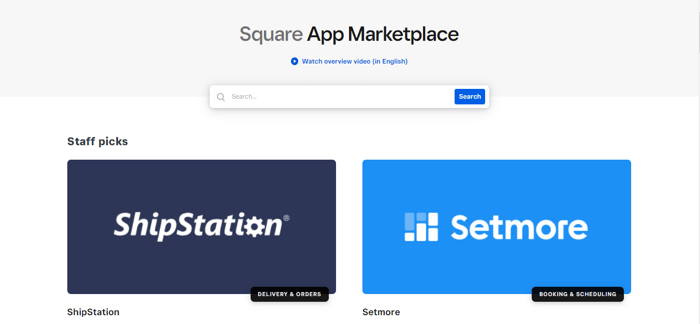
Some of the more popular integrations include other website builders, like WordPress and Wix, but also other helpful organizational and marketing tools, like Linktree, GoDaddy, and Acuity Scheduling.
Squarespace
Squarespace supports integrating with other apps which you can access from the Help Center. There are 11 different categories (shown in the image in the gray box to the right) that contain different apps that are built and fully supported by Squarespace. Most of them you can use for free in the paid plans, but some of them require a separate paid subscription.
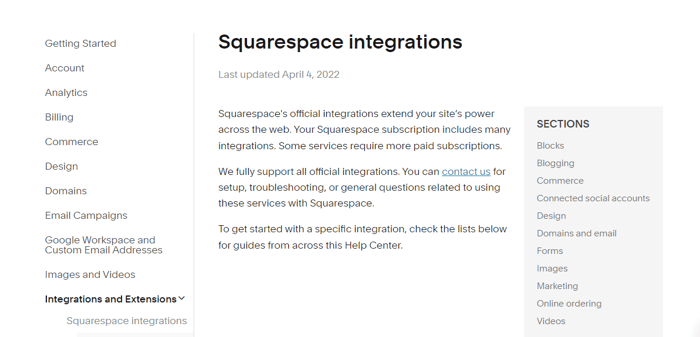
In case Squarespace’s official integrations don’t offer what you’re looking for, you can also browse through the Squarespace Extensions, which are third-party supported tools intended to “enhance your site and streamline key tasks, like sales tax compliance, dropshipping, SEO, and social media marketing,” in the words of Squarespace.
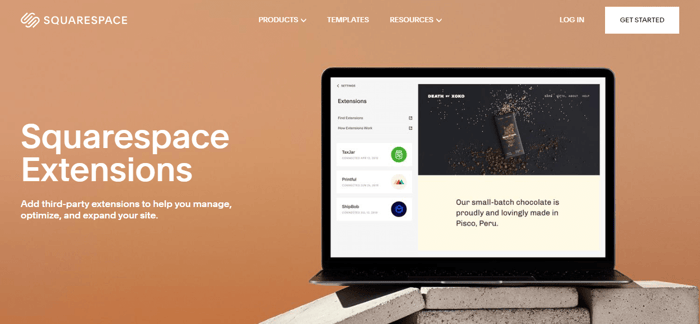
The extensions are also divided into categories:
Finance
Inventory and Products
Sales and Marketing
Shipping and Fulfillment
As with the integrations, most extensions are free. You can learn more about Squarespace’s extensions here.
Blogging
Nowadays, blogging is an important marketing tool for many businesses not only for promotional purposes but also to strengthen their relationship with their customers. So having a fully-functioning blog is kind of a must. The good thing is that both Square Online and Squarespace have blogging functionality, but one is slightly better than the other.
Square Online
Square’s blogging tool is called “Stories Overview,” and it functions as a “collection of stories across a variety of topics,” as Square Online puts it. Each “Story” represents a blog post, and all of the “Stories” are shown on the “Stories Overview” page. The layout is pretty basic, with a lot of white space, but it still looks nice and functional and will do a decent job.
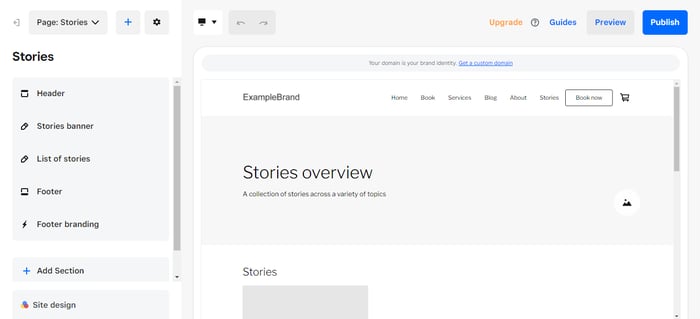
However, if this doesn’t do it for you, it’s better to opt for a more professional blogging solution that’s also easy to use and can seamlessly fit into your website, such as DropInBlog. It can be easily integrated into Square Online or any other platform where you’d like to include an awesome blogging functionality, so why not check it out?
Other than that, Square Online’s Stories Overview can be customized in the same way as the rest of the sections in the website builder. You can customize the fonts and colors of the sections, add images, change the background, edit the header and footer sections, and add your logo.
Squarespace
Compared to Square, Squarespace features a more well-rounded blogging functionality that not only looks more visually appealing but also boasts more features. You can choose between four different blog layouts, add meta descriptions, modify the URL slug, password-protect pages, add a social sharing image, and optimize your blog for Apple News, Apple Podcasts, and similar services.
Squarespace also allows injecting custom codes to enhance the header section and/or blog post items, which enables you to dress up your blog even more to your liking.
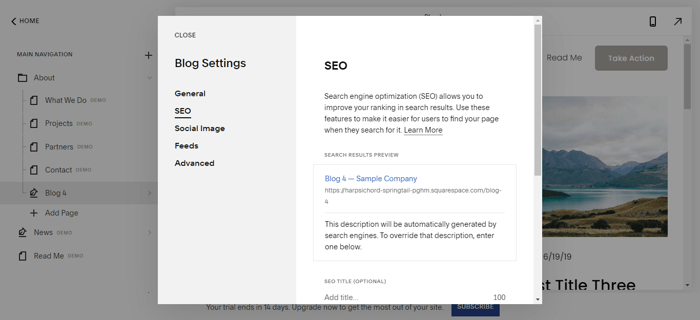
Support and Help Center
Square Online
Square Online provides customer support through email, live chat, and phone, which we really like. Additionally, you can find many useful guides in their Help Center, and if you can’t find what you’re looking for there, there’s the Seller Community, where you can browse or post a question.
Square Online makes it a little difficult to get a hold of the contact info of their support team. After some digging, we found that the best way to do so is through their support assistant, which then directed us to the right place. Square Online is available every day of the week from 6 a.m. to 6 p.m. PST.
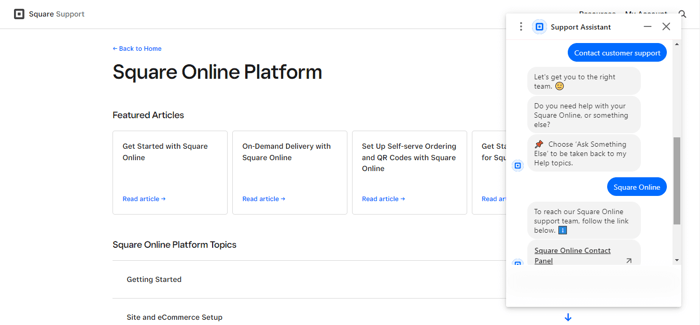
Squarespace
When it comes to support and customer service, we have to say that Squarespace wins hands down, and customer reviews on G2 seem to agree. This may sound unusual since Squarespace doesn’t offer phone support, but to make up for it, they do have a highly responsive team and a diverse pool of support options for all plans.
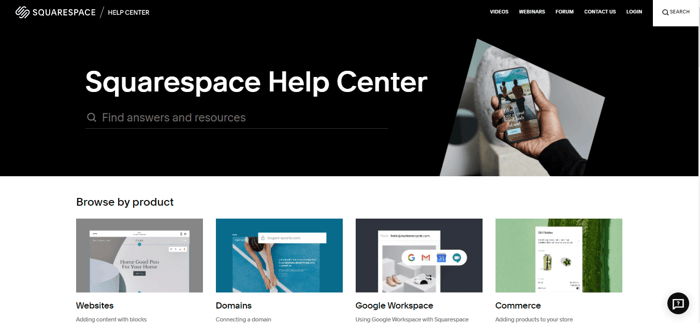
You can get Squarespace support via:
Live Chat Monday to Friday 8:00 a.m. to 8:00 p.m. EST
24/7 email support
24/7 Twitter support
Virtual support assistant
Community forum
Video tutorials
Webinars
In-depth and comprehensive guides
Our Verdict
It’s hard to proclaim that one is better than the other because, ultimately, they’re two different e-commerce platforms intended for different categories of business. What they do have in common is that they can both work well for small businesses, but then it really depends on what you need and what you prioritize.
If your goal is to build a recognizable brand, then Squarespace is your go-to, but Square Online can do a pretty decent job if you just need a nice and professional-looking site to start or run a small business.
In our opinion, the biggest difference between these two business software solutions is that Squarespace is a visual platform that offers some really good e-commerce features, while Square Online has more options for managing an inventory and making deliveries while offering a good-looking and functional site on the side. Which one you like better is ultimately your call, and we hope that our review of Square vs. Squarespace can help you make your choice.

